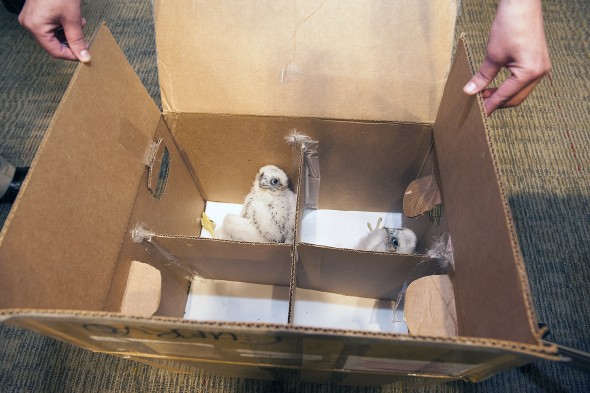UIC falcon enthusiasts swoop in to rescue fledgling

Falcon chicks Bob and Cheryl at about 24 days old, when they were brought inside for banding. The chicks, now grown, have left the nest. Photo: Roberta Dupuis-Devlin/UIC Photo Services
Chicago peregrine falcon fans swooped in last month to rescue a damsel in distress — Cheryl, one of UIC’s new falcons.
The falcon, born in May, glided away from the 28th floor ledge of University Hall for the first time June 22. She landed on the lawn near the Daley Library and couldn’t get back.
UIC peregrine enthusiasts quickly contacted Mary Hennen, director of the Chicago Peregrine Program and collections assistant in the Field Museum’s bird division.
Hennen captured the chick and released her on the top reaches of University Hall, near the nesting site.
The other new falcon, Bob, has also moved out, leaving parents Nitz and Mouse empty-nesters. “Bob fledged a few days later, without an issue,” said Hennen.
The pair, named for retired University of Illinois President Bob Easter and his wife, Cheryl, are now out in the world, learning to fly and hunt. “Four to five weeks after fledging, the birds are capable of surviving on their own and will disperse out of the area,” Hennen said.
Another rescue mission was also successful this week: peregrine falcons were officially removed from the Illinois list of threatened species — a goal over 30 years in the making.
University Hall was chosen as a release site in the 1980s to help reintroduce the species to the Midwest. Since then, the falcons have been removed from the federal threatened and endangered species list and reclassified on the state list from endangered to threatened.
There are now 29 nesting sites in Illinois, 20 of them in Chicago. A pair has nested outside University Hall since 1999.
This doesn’t mean the end of the Chicago Peregrine Program, though.
“The birds are still protected, even though they’re doing well,” Hennen said. Researchers will continue to band the birds, monitoring their longevity and dispersal.
Hennen visited UIC’s nesting site last month, where she collected blood samples and put leg bands on the chicks. The bands help experts identify where the birds are from, but no one can predict exactly where they’ll go.
“We can only say that it will be somewhere in the Midwest,” Hennen said.
But Bob might stop by sometime, she added. “Males choose territories closer to their natal site than females do.”
